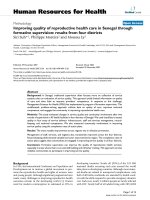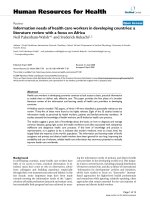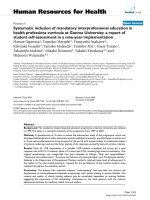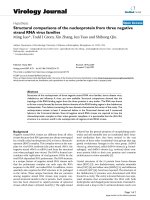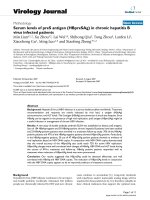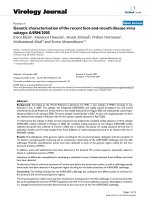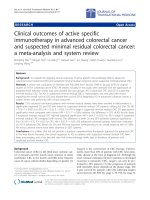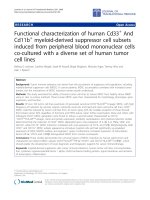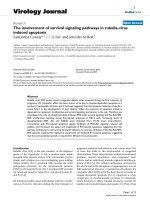Báo cáo sinh học: " Genetic characterization of measles viruses isolated in Turkey during 2000 and 2001" pdf
Bạn đang xem bản rút gọn của tài liệu. Xem và tải ngay bản đầy đủ của tài liệu tại đây (249.9 KB, 5 trang )
BioMed Central
Page 1 of 5
(page number not for citation purposes)
Virology Journal
Open Access
Research
Genetic characterization of measles viruses isolated in Turkey
during 2000 and 2001
Gulay Korukluoglu
1
, Stephanie Liffick
2
, Dalya Guris
3
, Fumio Kobune
1,4
,
Paul A Rota*
2
, William J Bellini
2
, Ali Ceylan
5
and Meliksah Ertem
5
Address:
1
National Measles/Rubella Laboratory, Refik Saydam National Hygiene Center, Ankara, Turkey,
2
Division of Viral and Rickettsial
Diseases, Centers for Disease Control and Prevention, Atlanta, Georgia, USA,
3
National Immunization Program, Centers for Disease Control and
Prevention, Atlanta, Georgia, USA,
4
Biomedical Sciences Association, Tokyo, Japan and
5
Department of Public Health, Dicle University School of
Medicine, Diyarbakir, Turkey
Email: Gulay Korukluoglu - ; Stephanie Liffick - ; Dalya Guris - ;
Fumio Kobune - _tokyo.ac.jap; Paul A Rota* - ; William J Bellini - ; Ali Ceylan - ;
Meliksah Ertem -
* Corresponding author
Abstract
Background: Molecular epidemiologic studies have made significant contributions to measles
surveillance activities by helping to identify source and transmission pathways of the virus. This
report describes the genetic characterization of wild-type measles viruses isolated in Turkey in
2000 and 2001.
Results: Wild-type measles viruses were isolated from 24 cases from five provinces in Turkey
during 2001. The viruses were analyzed using the standard genotyping protocols. All isolates were
classified as genotype D6, the same genotype that was identified in Turkey in previous outbreaks
during 1998.
Conclusion: Turkey has begun implementation of a national program to eliminate measles by
2010. Therefore, this baseline genotype data will provide a means to monitor the success of the
elimination program.
Background
Measles virus (MV), an enveloped virus with a single-
stranded, negative sense RNA genome, is a member of the
genus Morbillivirus within the family Paramyxoviridae. MV
is highly contagious and causes a disease characterized by
high fever, cough, coryza, conjunctivitis and appearance
of a maculopapular rash [1]. In many parts of the world,
vaccination programs have controlled measles. However,
despite the tremendous progress of global measles con-
trol, MV is still responsible for the deaths of approxi-
mately 700,000 thousand children each year, mostly in
developing countries [2]. Measles remains the most com-
mon of vaccine-preventable childhood mortality.
Although MV is considered to be monotypic, genetic vari-
ability exists among wild type strains [3]. Genetic charac-
terization of wild-type MVs is based on sequence analysis
of a hypervariable region (450 nt) of the nucleoprotein
(N) gene and the full-length hemagglutinin (H) gene. A
standard nomenclature and analysis protocol for describ-
ing the genetic characteristics of wild-type MVs was estab-
lished by the World Health Organization (WHO) [4-7].
Published: 19 July 2005
Virology Journal 2005, 2:58 doi:10.1186/1743-422X-2-58
Received: 20 June 2005
Accepted: 19 July 2005
This article is available from: />© 2005 Korukluoglu et al; licensee BioMed Central Ltd.
This is an Open Access article distributed under the terms of the Creative Commons Attribution License ( />),
which permits unrestricted use, distribution, and reproduction in any medium, provided the original work is properly cited.
Virology Journal 2005, 2:58 />Page 2 of 5
(page number not for citation purposes)
WHO recommends that genetic analysis of MV isolates
should be conducted during all phases of measles control.
Genetic analysis of wild-type MVs has provided an
increasingly comprehensive picture of the worldwide dis-
tribution of MV genotypes [8]. Molecular epidemiologic
studies can help to measure transmission pathways and to
clarify epidemiological links during outbreaks. Virologic
surveillance can also help to measure the success of mea-
sles vaccination programs by documenting the interrup-
tion of transmission of the endemic viral genotype(s)
[9,10].
In 2001, Turkey experienced a large measles epidemic and
the number of reported measles cases was over 30,000
[11]. From October 2000 to August 2001, we isolated MVs
from measles cases in five different provinces of Turkey.
Since Turkey has recently initiated a program to eliminate
measles, this report provides important baseline data that
will allow future molecular epidemiologic studies to help
measure the success of this program.
Results and Discussion
With the exception of one specimen that was collected in
October 2000, the remaining specimens were collected
between February and August in 2001 (Table 1). MV iso-
lates were obtained from 24 specimens collected from
widely dispersed areas of Turkey, including the provinces
of Ankara, Sinop, Diyarbakir, Sirnak, and Ardahan (Figure
1, Table 1). Measles specific IgM antibody was detected in
serum samples from 16 of 20 cases, while serologic results
were not available for 4 cases. The serum samples from 3
of the 4 IgM negative cases were taken 2 days after rash
onset when the sensitivity of IgM detection is low.
Comparison of the N gene sequences of the Turkish
viruses with the sequences of the current of WHO refer-
ence strains showed that all 24 Turkish strains were mem-
bers of genotype D6 (Figure 2). The sequences of the
Turkish viruses were closely related to each other showing
no more than 1.3% nucleotide heterogeneity overall. In
fact, the N gene sequences of 21 of these MV isolates were
identical, though they came from different regions of Tur-
key. Although the Turkish viruses were clearly in genotype
D6, the sequences of the more recently isolated viruses
formed a distinct group relative to other genotype D6
viruses recently isolated in Germany, Luxembourg, Brazil
and the United States [10,18-20]. However, the nucle-
otide sequences from the Turkish cluster differed from the
sequences of the non-Turkish viruses by no more than
1.1% overall. The sequence of a single isolate from Ankara
in 2000, MVi/Ankara.TUR/38.00, and a genotype D6 iso-
late from the 1998 outbreak, MVi/Ankara/10-98-4 [21],
Table 1: Epidemiological and serological information on measles virus isolates from Turkey.
WHO Name [Genotype] Age Measles IgM Date of after
rash
Cell lines used
for isolation
Type of specimen Province Epi-link
MVi/Ankara.TUR/38.00 [D6] 7 y positive 3 B95 a urine Ankara sporadic
MVi/Ankara.TUR/05.01 [D6] 17 y negative 2 B95 a urine Ankara sporadic
MVi/Ankara.TUR/06.01-1 [D6] 24 y negative 2 B95 a urine Ankara sporadic
MVi/Ankara.TUR/06.01-2 [D6] 21 y negative 2 B95 a urine Ankara epidemic
MVi/Ankara.TUR/07.01 [D6] 2.5 y ? ? B95 a urine Ankara sporadic
MVi/Sinop.TUR/11.01-1 [D6] 13 y positive 4 B95 a urine Sinop epidemic
MVi/Sinop.TUR/11.01-2 [D6] 13 y positive 5 B95 a urine Sinop epidemic
MVi/Sinop.TUR/11.01-3 [D6] 13 y positive 4 B95 a throat swab Sinop epidemic
MVi/Sinop.TUR/11.01-4 [D6] 13 y positive 3 B95 a urine Sinop epidemic
MVi/Sinop.TUR/11.01-5 [D6] 13 y positive 4 B95 a urine Sinop epidemic
MVi/Sinop.TUR/11.01-6 [D6] 13 y positive 4 B95 a throat swab Sinop epidemic
MVi/Ankara.TUR/14.01 [D6] ? positive ? B95 a nasal swab Ankara sporadic
MVi/Ankara.TUR/19.01-1 [D6] 25 y. ? 3 COBL urine Ankara sporadic
MVi/Ankara.TUR/19.01-2 [D6] ? ? ? COBL urine Ankara sporadic
MVi/Ardahan.TUR/23.01 [D6] ? ? ? COBL urine Ardahan epidemic
MVi/Sirnak.TUR/29.01-1 [D6] 3 y. negative 5 COBL urine Şırnak epidemic
MVi/Sirnak.TUR/29.01-2 [D6] 3 y. positive 3. COBL throat swab Şırnak epidemic
MVi/Sirnak.TUR/29.01-4 [D6] 3 y. positive 7 COBL urine Şırnak epidemic
MVi/Sirnak.TUR/29.01-5 [D6] 4 y. positive 3 COBL urine Şırnak epidemic
MVi/Sirnak.TUR/29.01-6 [D6] 2 y. positive 5 COBL urine Şırnak epidemic
MVi/Sirnak.TUR/29.01-7 [D6] 8 mo. positive 6 COBL blood Şırnak epidemic
MVi/Diyarbakir.TUR/30.01-1 [D6] 7 y. positive 4 COBL blood Diyarbakırepidemic
MVi/Diyarbakir.TUR/30.01-2 [D6] 7 y. positive 2 COBL urine Diyarbakırepidemic
MVi/Ankara.TUR/30.01 [D6] 2 y. positive ? COBL urine Ankara sporadic
Virology Journal 2005, 2:58 />Page 3 of 5
(page number not for citation purposes)
were more closely related to the sequences of the Euro-
pean, and Brazilian genotype D6 viruses than the
sequences of the Turkish cluster (Figure 2).
At present, genotype D7 appears to be the most frequently
detected genotype in Western European countries; how-
ever, D6 genotype is still circulating in some European
countries including the Russian Federation [6,19]. Geno-
type D6 viruses were imported to the United States from
various European countries and Brazil on 13 occasions
between 1997 and 2000; however, after 2000, only 2 gen-
otype D6 viruses were detected in the United States (Rota,
unpublished).
In some parts of Europe, measles is near elimination or
has been eliminated, whereas in others measles is still
endemic [22]. Despite an active vaccination program,
measles has been an endemic disease in Turkey with epi-
demics occurring every 3–4 years. In 2001, the last epi-
demic year, over 30.000 cases were reported [11]. The
previous epidemic year was 1998, when more than
27,000 cases were reported. The virologic surveillance
data suggest that viruses in genotype D6 were responsible
for both epidemics and continued to circulate during the
inter-epidemic periods.
To reduce measles morbidity and mortality in Turkey, the
Ministry of Health launched a National Measles Elimina-
tion Program in 2002. In parallel with the strategic plan of
the European Regional Office of WHO, the Turkish
national plan targets elimination of measles by 2010 [23].
The plan included a "catch-up" vaccination campaign tar-
geting nearly 20 million children between 9 months and
14 years of age to be conducted in two phases during
December 2003 and 2005 [24]. The National Measles
Plan also includes activities for establishing a laboratory
based surveillance system to monitoring the effectiveness
of the measles elimination program [25]. In Turkey, sub-
national laboratories from seven selected provinces will
carry out laboratory-based surveillance, each representing
a region of the country. These sub-national laboratories
will perform serologic confirmation of suspected measles
cases. Clinical specimens collected from laboratory-con-
firmed cases will be sent to the National Measles and
Rubella Laboratory for virus isolation and genotyping.
Conclusion
Genetic analysis of MVs isolated after the measles vaccina-
tion campaigns will help to determine if the circulation of
the endemic genotype D6 viruses is interrupted. This anal-
ysis would not be possible without the baseline data pre-
sented in this report. Turkey is in a unique geographic
position to monitor transmission of measles virus
between Europe, the Middle East and the rest of Asia.
Strengthening virologic surveillance capacity in Turkey
will benefit several WHO regions.
Materials and methods
Clinical specimens
Urine, nasopharyngeal secretions and blood samples were
collected from 24 patients who had acute, febrile maculo-
papular rash from five different provinces in Turkey. All
clinical samples were collected within six days of rash
onset and transported to Refik Saydam Hygiene Center,
National Measles and Rubella Laboratory in accordance
with standard protocols (Table 1). Isolation of MV was
performed using the B95a cell line (12) for 12 samples
and the COBL cell line (IL-II treated human cord blood
cells, 13) for 15 samples. Syncytia formation, the cyto-
pathic effect (CPE) characteristic of MV infection,
appeared within 1–7 days. When the CPE was advanced
the cultures were harvested and stored at -80°C. All iso-
lates were confirmed as measles by a neutralization test
performed by using monospecific rabbit antibody to the
H protein.
Sequence analysis
RNA was extracted from infected cells using the guanidin-
ium acid-phenol technique [14]. The 450 nucleotides cor-
responding to the COOH-terminal 150 amino acids of the
N protein were amplified by using a one-step RT-PCR kit
according to manufacturer's protocol (Superscript, Invit-
rogen). Forward and reverse primers were: 5'GCTAT-
GCCATGGGAGTAGGAGTGG and
5'CTGGCCCTCGGCCTCTCGCAC, respectively.
Sequences of the PCR products were derived by auto-
mated sequencing with the BigDye terminator VI.I
Map of Turkey showing province and number of measles virus isolates obtained during 2000–2001Figure 1
Map of Turkey showing province and number of measles
virus isolates obtained during 2000–2001.
Figure 1. Map of Turkey showing province and number of measles virus
isolates obtained during 2000-2001.
Ankara (10)
Sinop (6) Ardahan (1)
Sirnak (7)
Diyarbakir (3)
Virology Journal 2005, 2:58 />Page 4 of 5
(page number not for citation purposes)
Phylogenetic analysis of the N gene sequences of wild-type MVs isolated in TurkeyFigure 2
Phylogenetic analysis of the N gene sequences of wild-type MVs isolated in Turkey. Sequences of the Turkish viruses were
compared to the sequence of the WHO reference strains (genotype shown in bold). Turkish viruses are indicated by arrows.
Sequences of previously described genotype D6 viruses [10, 8–20] are also included in this un-rooted tree.
NJ.USA 94 D6
MVi/Ankara.TUR/10.98-4
Vermont.USA/28.98
Michigan.UAS/52.99
New York.USA/7.00
Quebec.CAN/24.00
Buenos Aires.ARG/98
Minnesota.USA/33.97
Rio de Janeiro.BRA/902.97
Sao Paulo.BRA/42.97
Buenos Aires.ARG/52.02
Luxembourg.LUX/31.97
Luxembourg.LUX/30.97-2
Luxembourg.LUX/30.97-1
Dudelange.LUX/25.96
California.USA/5.96
New York.USA/3.96
Massachusetts.USA/30.97
Florida.USA/19.97
New York.USA/16.98
Washington.USA/17.98
California.USA/8.00
MVP.UK/74 D1
Bangkok.THA/93 D5
Palau.BLA/93 D5
Illinois.USA/99 D7
Vic.AUS/85 D7
Manchester.UK/94 D8
Montreal.CAN/89 D4
Johannesburg.SOA/88 D2
Braxator.DUE/71 E
JM.USA/77 C2
WTF.DEU/90 C2
Tokyo.JPN/84K C1
Ibadan.NIE/97 B3
NY.USA/94 B3
Yaounde.CAE/83 B1
Libreville.GAB/84 B2
Madrid.SPA/94 F
Amsterdam.NET97 G2
Vic.AUS/99 G3
Berkeley.USA/83 G1
Beijing.CHN/94 H2
Hunan.CHN/93 H1
1 change
MVi/Ankara.TUR/14.01
MVi/Ardahan.TUR/23.01
MVi/Ankara.TUR/19.01-1
MVi/Ankara.TUR/19.01-2
MVi/Sirnak.TUR/29.01-2
MVi/Sirnak.TUR/29.01-5
MVi/Sirnak.TUR/29.01-4
MVi/Sirnak.TUR/29.01-2
MVi/Ankara.TUR/30.01
MVi/Sirnak.TUR/29.01-7
MVi/Diyarbakir.TUR/30.01-1
MVi/Diyarbakir.TUR/30.01-2
MVi/Sirnak.TUR/29.01-1
MVi/Ankara.TUR/5.01
MVi/Sinop.TUR/11.01-5
MVi/Sinop.TUR/11.01-2
MVi/Sinop.TUR/11.01-1
MVi/Sinop.TUR/11.01-6
MVi/Ankara.TUR/06.01-1
MVi/Sinop.TUR/11.01-4
MVi/Ankara.TUR/06.01-2
MVi/Sinop.TUR/11.01-3
MVi/Ankara.TUR/07.01
MVi/Ankara.TUR/05.01
MVi/Ankara.TUR/38.00
Publish with BioMed Central and every
scientist can read your work free of charge
"BioMed Central will be the most significant development for
disseminating the results of biomedical research in our lifetime."
Sir Paul Nurse, Cancer Research UK
Your research papers will be:
available free of charge to the entire biomedical community
peer reviewed and published immediately upon acceptance
cited in PubMed and archived on PubMed Central
yours — you keep the copyright
Submit your manuscript here:
/>BioMedcentral
Virology Journal 2005, 2:58 />Page 5 of 5
(page number not for citation purposes)
chemistry according to the manufacturer's protocol (Per-
kin Elmer-Applied Biosystems, Foster City, CA). Sequence
reaction product results were analyzed on an automatic
sequencer (ABI 3100, Perkin Elmer Applied Biosystems,
Foster City, CA). Sequence data were analyzed by using
version 10.0 of the Genetics Computer Group Sequence
Analysis Software Package [15] and phylogenetic analyses
were performed using PHYLIP ver 3.4 [16] and PAUP ver
4.0 [17]. All phenograms were drawn as unrooted trees.
Sequence data were deposited in GenBank under acces-
sion numbers (AY899306
-AY899329).
List of Abbreviations
MV: measles virus
N: nucleoprotein
COOH- carboxyl
WHO: World Health Organization
Competing interests
The author(s) declare that they have no competing
interests.
Authors' contributions
GK, FK, AC, ME collected specimens and performed virus
isolation and measles IgM assays; GK, FK established
COBL cell in the Ankara laboratory; GK, SL, PR performed
RT-PCR and sequence analysis; GK, DG, PP, WB analyzed
data and prepared draft manuscript. All authors revised
manuscript and approved final draft.
Acknowledgements
The authors would like to thank the field staff in Turkey for obtaining
appropriate clinical samples and for providing epidemiologic data for the
cases. The CDC laboratory is a WHO Measles Strain Bank.
References
1. Griffin E: Measles virus. In Fields Virology Volume 1. 4th edition.
Edited by: Knipe DM, Howley PM. Philadelphia: Lippincott Williams
and Wilkins; 2001:1401-1441.
2. WHO: Progress in reducing global measles deaths: 1999–
2002. Weekly Epidemiol Rec 2004, 79:13-24.
3. Bellini WJ, Rota PA: Genetic diversity of wild type measles
virus: implication for global measles elimination programs.
Emerg Infect Dis 1998, 4:29-35.
4. WHO: Standardization of the nomenclature for describing
the genetic characteristics of wild type measles viruses. Wkly
Epidemiol Rec 1998, 73:265-272.
5. WHO: Nomenclature for describing the genetic characteris-
tics of wild type measles viruses (update). Part 1. Wkly Epide-
miol Rec 2001, 76:241-247.
6. WHO: Nomenclature for describing the genetic characteris-
tics of wild type measles viruses (update). Part 2. Wkly Epide-
miol Rec 2001, 76:249-251.
7. WHO: Update of the nomenclature for describing the
genetic characteristics of wild-type measles viruses: new
genotypes and reference strains. Wkly Epidemiol Rec 2003,
78:229-232.
8. Rota PA, Bellini WJ: Update on the global distribution of geno-
types of wild-type measles viruses. J Inf Dis 2003, 187:270-276.
9. Rota JS, Heath JL, Rota PA, King GE, Celma ML, Carabaña J, Fernan-
dez-Muñoz R, Brown D, Jin L, Bellini WJ: Molecular epidemiology
of measles virus: Identification of pathways of transmission
and the implications for measles elimination. J Inf Dis 1996,
173:32-37.
10. Rota PA, Rota JS, Redd S, Papania M, Bellini WJ: Genetic Analysis
of Measles Viruses Isolated in the United States between
1989 and 2001: Absence of an Endemic Genotype Since
1994. J Inf Dis 2004, 189:171-176.
11. Guris D, Bayazit Y, Ozdemirer U: Measles Epidemiology and
Elimination Strategies in Turkey. J Inf Dis 2003, 187:230-234.
12. Kobune , Sakata H, Sugiura A: Marmoset lymphoblastoid cell as
sensitive host for isolation of measles virus. J Virol 1990,
64:700-705.
13. Kobune F: 10–11 May 2001. WHO Meeting "1st National Mea-
sles Laboratory Network" Geneva, Switzerland. .
14. Chomczynski P, Sacchi N: Single step method of RNA isolation
by acid guanidinium thiocyanate-phenol-cholorform
extraction. Anal Biochem 1987, 162:156-159.
15. Devereaux J, Haeberli P, Smithies O: A comprehensive set of
sequence analysis programs for the VAX. Nucleic Acids Res
1984, 12:387-395.
16. Felsenstein J: Phylogenies from molecular sequences: infer-
ences and reliability. Am Rev Genet 1988, 22:512-565.
17. Swofford DL: PAUP:phylogenetic analysis using parsimony. Version 3.1.1
Champaign, IL: Illinois Natural History Survey, Champaign, IL; 1988.
18. Oliveira MI, Rota PA, Curti SP, Figueiredo CA, Afonso AMS: Genetic
homogeneity of measles viruses associated with a measles
outbreak, Sao Paulo, Brazil, 1997. Emerg Infect Dis 2002,
8:808-813.
19. Santibanez S, Heider A, Gerike E, Agafonov A, Schreier E: Genotyp-
ing of measles virus isolates from central Europe and Russia.
J Med Virol 1999, 58:313-320.
20. Tischer A, Santibanez S, Siedler A, Heider A, Hengel H: Laboratory
investigations are indispensable to monitor the progress of
measles elimination – results of the German Measles Senti-
nel 1999–2003. J Clin Virol 2004, 31:165-178.
21. Yılmaz N, Rota PA, Tasyurek T: Genetic characterization of
measles virus isolated in Turkey. Proceedings of The National Con-
ference of Moleculer Biology and Diagnostic Microbiology, Nevsehir, Turkey
2000.
22. Spika J, Steven W, Richard P: Measles and rubella in the World
Health Organization European Region: diversity creates
challenges. J Inf Dis 2003, 187:191-197.
23. World Health Organization Database [http://
www.euro.who.int/document/e81567.pdf]
24. World Health Organization Database [http://
www.euro.who.int/vaccine/20031229-1]
25. World Health Organization Database [ />document/E82183.pdf]
